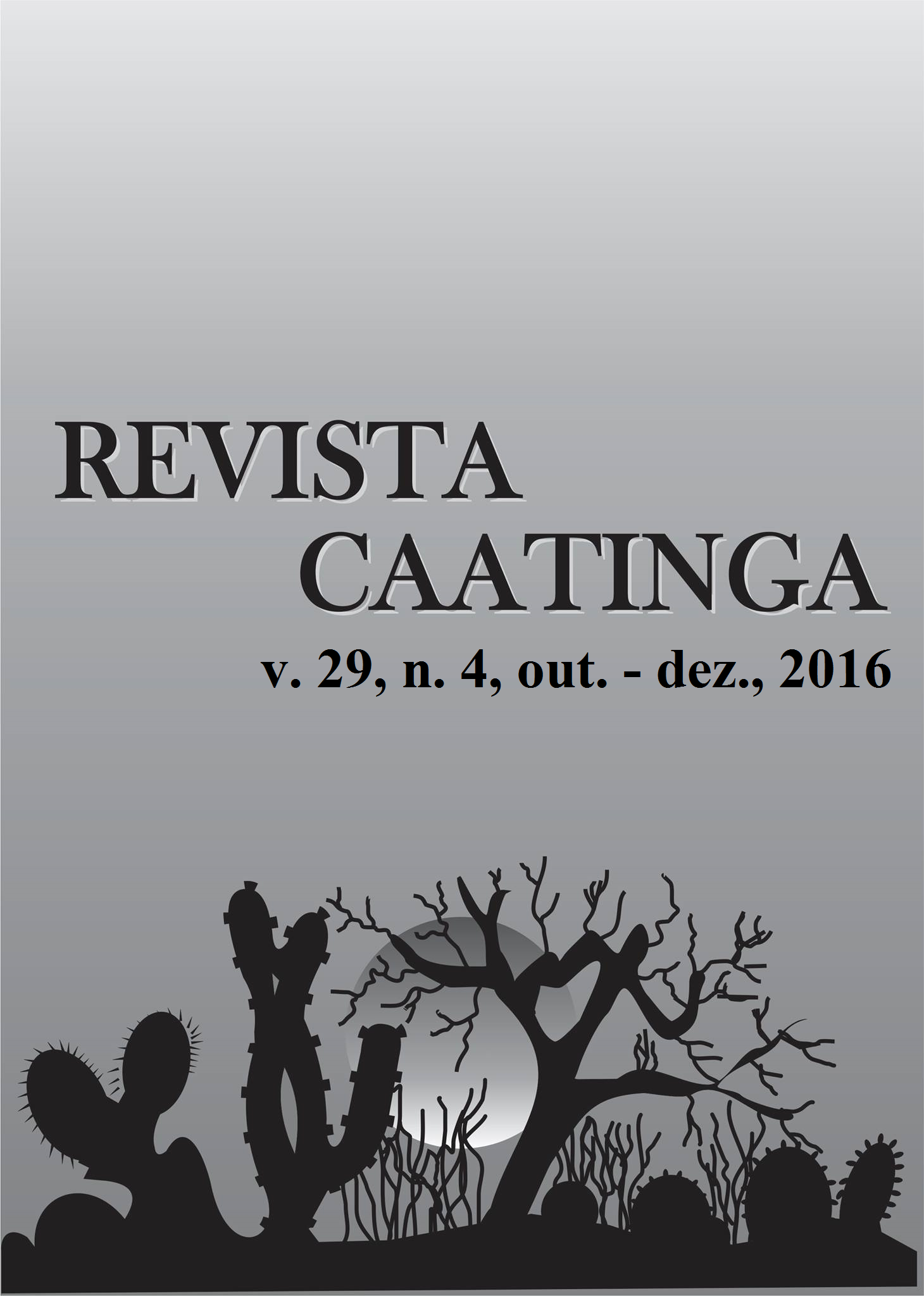MINI TOMATO CULTIVARS FOR THE SUB-MID SÃO FRANCISCO VALLEY, BRAZIL
DOI:
https://doi.org/10.1590/1983-21252016v29n427rcKeywords:
Solanum lycopersicum L.. Yield. Semiarid region.Abstract
Two experiments were conducted in Petrolina, State of Pernambuco (PE), Brazil, in order to evaluate the performance of mini tomato cultivars under the conditions of the Sub-Mid São Francisco Valley. One on crops of the second half of the year (SH) from August to December 2012, and other on crops of the first half of the year (FH) from March to July 2013. Six mini tomato cultivars were evaluated in both seasons: E5663, Kada, F1170, Tanzimech, E1275 and Abirú. A randomized block experimental design was used, with four replications, arranged in split plot, with the growing seasons in the plots and cultivars in the subplots. The total and commercial fruit yield, soluble solid contents, fruit yield per plant, number of fruits per plant, and fruit fresh weight were evaluated. The total yield was higher in the FH, regardless of the cultivar used. The cultivar E5663 presented yield of 40.3 Mg ha-1 in the SH and 104.0 Mg ha-1 in the FH. Commercial yield, soluble solid content and yield per plant followed the same trend. The number of fruits per plant ranged from 390.8 to 941.4 (FH) and from 80.5 to 315.4 (SH). The cultivar E5663 presented the best yield and soluble solid content responses, thus, it may be recommended for the conditions of Petrolina PE, and can be adopted for planting in both seasons evaluated.Downloads
References
BRANDÃO FILHO, J. U. T; CALLEGARI, O. Cultivo de hortaliças de frutos em solo em ambiente protegido. Informe Agropecuário, Belo Horizonte, v. 20, n. 200/201, p. 64-68, 1999.
CAVALCANTE, F. J. A. (Coord.). Recomendações de adubação para o estado de Pernambuco: 2ª aproximação. Recife, PE: IPA, 2008. 212 p.
EMBRAPA. Centro Nacional de Pesquisa de Solos. Sistema brasileiro de classificação de solos. 2ª. ed. Rio de Janeiro, RJ: Embrapa Solos, 2006. 306 p.
FERREIRA, D. F. SISVAR Versão 5.3. Lavras: Departamento de Ciências Exatas, UFLA. 2010.
FILGUEIRA, F. A. R. Novo manual de olericultura: agrotecnologia moderna na produção e comercialização de hortaliças. Viçosa, MG: Editora UFV, 2008. 421 p.
FONTES, P. C. R.; SILVA, D. J. H. Cultura do tomate. In: FONTES, P. C. R. (Ed.). Olericultura: teoria e pratica. 1 ed. Viçosa: Editora UFV, 2005. cap. 29, p. 457-475.
GIORDANO, L. B. et al. Seleção de linhagens com tolerância ao calor em germoplasma de tomateiro coletada na região Norte do Brasil. Horticultura Brasileira, Brasília, v. 23, n. 1, p. 105-107, 2005.
GOMES, F. P. Curso de estatística experimental. 14. ed. São Paulo, SP: NOBEL, 2000. 477 p.
GUSMÃO, M. T. A.; GUSMÃO, S. A. L.; ARAÚJO, J. A. C. Produtividade de tomate tipo cereja cultivado em ambiente protegido e em diferentes substratos. Horticultura Brasileira, Brasília, v. 24, n. 4, p. 431-436, 2006.
IBA, K. Aclimative response to temperature stress in higher plants: approaches of gene engineering for temperature tolerance. Annual Review Plant Biology, Palo alto, v. 53, p. 225-245, 2002.
INSTITUTO BRASILEIRO DE GEOGRAFIA E ESTATÍSTICA - IBGE. Levantamento Sistemático da Produção Agrícola. Rio de Janeiro, v. 26. p. 1-86, 2013.
LSPA: Levantamento Sistemático da Produção Agrícola. Rio de Janeiro, v. 23, p. 1-80, 2010.
PENA, M. A. N. A. et al. Adaptabilidade e estabilidade de genótipos de tomateiro sob cultivo em solo de terra firme e várzea da Amazônia infestados por Ralstonia solanacearum. Bragantia, Campinas, v. 69, n. 1, p. 27-37, 2010.
PICKEN, A. J. F. A review of pollination and fruit set in the tomato (Lycopersicon esculentum Mill.). Journal Horticultural Science, Ashford, v. 59, n. 1, p. 1-13, 1984.
SANTOS, L. S. Murcha bacteriana, tolerância a altas temperaturas e pegamento de frutos em tomateiro. 2010. 16 f. Monografia (Graduação em Agronomia) - Universidade Federal Rural de Pernambuco, Recife, 2010.
SEDIYAMA, M. A. N.; FONTES, P. C. R.; SILVA, D. J. H. Práticas culturais adequadas ao tomateiro. Informe Agropecuário, Belo horizonte, v. 24, n. 219, p. 19-25, 2003.
SILVA JUNIOR, A. A.; PRANDO, H. F. Cultivares e épocas de semeadura de tomate para o litoral catarinense. Agropecuária Catarinense, Florianópolis, v. 9, n. 4, p. 48-50, 1989.
SIMONNE, E. et al. Field performance, chemical composition and sensory evaluation of red and yellow grape tomato varieties. Proceedings Florida State Horticultural Society, Tallahassee, v. 118, p. 376-378, 2005.
SILVA, A. C. et al.Avaliação de linhagens de tomate cereja tolerantes ao calor sob sistema orgânico de produção. Revista Caatinga, Mossoró, v. 24, n. 3, p. 33 - 40, 2011.
SOBREIRA, F. M. et al. Qualidade de sabor de tomates dos tipos salada e cereja e sua relação com caracteres morfoagronômicos dos frutos. Revista Ciência e Agrotecnologia, Lavras, v. 34, n. 4, p. 1015-1023, 2010.
SOUZA, N. Tomate mais doce e sem acidez. Jornal O Estado de São Paulo. São Paulo, 8 p., jun. 2007.
Downloads
Published
Issue
Section
License
Os Autores que publicam na Revista Caatinga concordam com os seguintes termos:
a) Os Autores mantêm os direitos autorais e concedem à revista o direito de primeira publicação, com o trabalho simultaneamente licenciado sob a Licença Creative Commons do tipo atribuição CC-BY, para todo o conteúdo do periódico, exceto onde estiver identificado, que permite o compartilhamento do trabalho com reconhecimento da autoria e publicação inicial nesta revista, sem fins comerciais.
b) Os Autores têm autorização para distribuição não-exclusiva da versão do trabalho publicada nesta revista (ex.: publicar em repositório institucional ou como capítulo de livro), com reconhecimento de autoria e publicação inicial nesta revista.
c) Os Autores têm permissão e são estimulados a publicar e distribuir seu trabalho online (ex.: em repositórios institucionais ou na sua página pessoal) a qualquer ponto antes ou durante o processo editorial, já que isso pode gerar alterações produtivas, bem como aumentar o impacto e a citação do trabalho publicado (Veja O Efeito do Acesso Livre).







